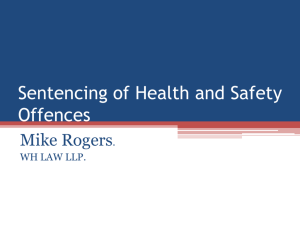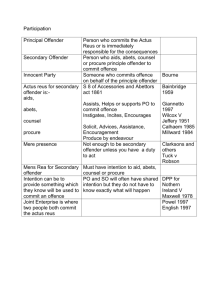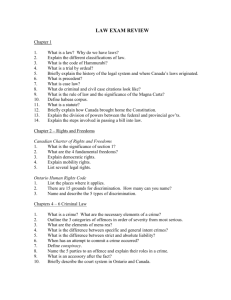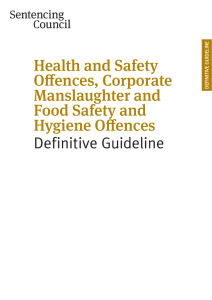9-the aims of punishment and principles of sentencing
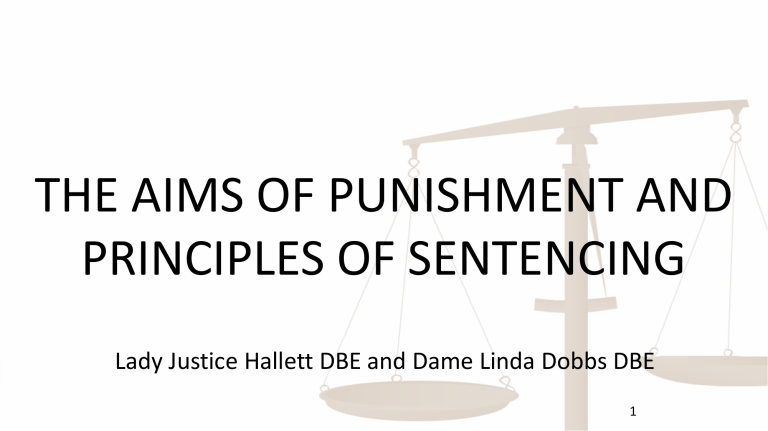
THE AIMS OF PUNISHMENT AND
PRINCIPLES OF SENTENCING
Lady Justice Hallett DBE and Dame Linda Dobbs DBE
1
WHY DO PEOPLE BREAK THE LAW?
• Social circumstances
• Environmental
• Psychological
• Addictions
• Other
2
AIMS OF PUNISHMENT
• Punishment
• Reform and rehabilitation of offenders
• Protection of the public
• Reparation
• Reduction of crime (including deterrence which can be general and individual)
3
PUNISHMENT
• Punishment, in the sense of the sentence imposed by the court, is governed by the law. It can only be for an offence against the law, against an actual offender and is imposed by those authorised to do so (judges) and must always be within the parameters of sentences available under the law. It is punishment in the name of the state against those who have violated state criminal laws.
4
REFORM/REHABILITATION
• The aim is to change the ways of the criminal, to get them to understand what led to the commission of the crime and helping them to address the causes and to become responsible citizens. Non-custodial measures have a significant part to play.
5
PROTECTION OF THE PUBLIC
• Society needs protecting from criminals, particularly those who carry out serious crimes which can have long lasting and often fatal consequences. By containing them in prison, society is protected from dangerous criminals.
6
REPARATION
• The offender makes reparation by paying back the victim what has been taken or by repairing what has been damaged , paying compensation or similar gesture of making good.
7
REDUCTION OF CRIME
( INCLUDING DETERRENCE)
• The aim is to stop the offender committing further crime and prevent others from committing crime.
8
SENTENCING PRINCIPLES
• Sentence should be commensurate with the seriousness of the offence.
• The seriousness of the offence is determined by culpability and harm or risk caused by the offence.
• The level of culpability of the offender will depend on whether the harm caused was intentional, reckless or negligent.
9
SENTENCING PRINCIPLES (2)
• The harm caused may be physical injury, sexual violation, financial loss, damage to health or psychological effects.
• There will be gradations of harm within these categories.
Harm may be to an individual or to a group of people or the community at large.
10
SENTENCING PRINCIPLES (3)
• Assessing seriousness (i.e. culpability and harm)is a difficult task, particularly where there is an imbalance between culpability and harm.
• Sometimes the harm that actually results is greater than the harm intended by the offender.
• In other circumstances, the offender’s culpability may be at a higher level than the harm resulting from the offence.
11
SENTENCING PRINCIPLES (4)
• The precise level of culpability will be determined by such factors as motivation, whether the offence was planned or spontaneous or whether the offender was in a position of trust.
• Culpability will be greater if an offender deliberately causes more harm than is necessary for the commission of the offence, or where an offender targets a vulnerable victim (because of their old age or youth, disability or by virtue of the job they do).
12
SENTENCING PRINCIPLES (5)
• Where unusually serious harm results and was unintended and beyond the control of the offender, culpability will be significantly influenced by the extent to which the harm could have been foreseen.
• If much more harm, or much less harm has been caused by the offence than the offender intended or foresaw, the culpability of the offender, depending on the circumstances, may be regarded as carrying greater or lesser weight as appropriate.
13
SENTENCING PRINCIPLES (6)
• Aggravating and mitigating factors will be relevant to the assessment of seriousness
• Once the court has assessed the seriousness of the offence, the court has to consider the circumstances of the offender and any offender mitigation. This is very important.
14
